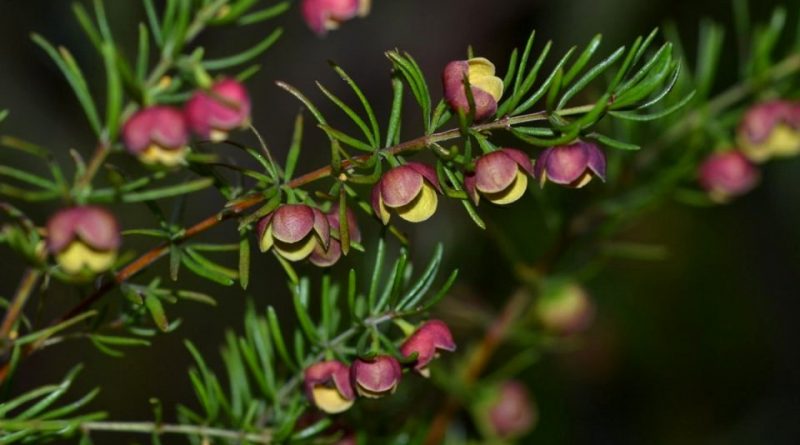Boronia megastigma
Boronia megastigma
Brown Boronia (Boronia megastigma Bartl.) Is a shrubby species belonging to the Rutaceae family.
Systematic –
From a systematic point of view it belongs to the Eukaryota Domain, Plantae Kingdom, Magnoliophyta Division, Magnoliopsida Class, Rosidae Subclass, Sapindales Order, Rutaceae Family and therefore to the Genus Boronia and to the Species B. megastigma.
The terms are synonymous:
– Boronia megastigma var. aurea Anon .;
– Boronia megastigma var. aurea W. Mill. & N. Taylor nom. illeg., nom. superfl .;
– Boronia megastigma Bartl. var. megastigma;
– Boronia tristis Turcz.
Etymology –
The term Boronia of the genus was dedicated to the Italian botanist Francesco Borone (1769-1794), collaborator of Sir James Smith and Humphrey Sibthorp in Greece.
The specific megastigma epithet comes from the Greek μέγας mégas grande, long and from the botanical Latin stigma (see): with a very large, long stigma.
Geographical Distribution and Habitat –
Brown Boronia is a plant that grows in swamps and wet forests, mainly in the Karri forests and at the southern edges of the jarrah forests between Harvey and Cape Riche in the southern region of Western Australia.
Description –
Boronia megastigma is a thin, erect shrub that typically grows to a height of 1–2 m and has thin branches covered with fine and soft hair.
The leaves are sessile with three or five thick, thin, 10-20 mm long and strongly aromatic linear leaflets.
The flowers are carried individually, to the axil of the leaves, on a peduncle of about 10 mm; they are shaped like a long cup, aromatic and sometimes in large numbers along the flowering branches. They have four egg-shaped sepals, hairless and about 2 mm long. The four petals are more or less round, 6-7 mm long, reddish brown to dark brown or purplish black on the outside and yellow on the inside. Sometimes even the petals are yellow on the outside. There are eight stamens near the sepals and a more or less round purple anther, about 1 mm long and sterile. The stamens near the petals have a similar anther but pale yellow and fertile. The stigma is unusually large, dark purple or black with four lobes.
Cultivation –
Boronia megastigma is a plant grown mainly for its intense and attractive scent.
It is a plant that prefers fairly moist but well-drained soils but also adapts quite well in numerous places outside the natural habitat.
The cultivation of Boronia megastigma in a pot allows you to control and maintain conditions such as those of a fresh soil, with a slightly acidic, humid and well-drained pH.
The plant grows best in mid-shade conditions. Mulching is also useful for keeping the soil moist, as long as the soil is well drained as plants are prone to rot. The plant is sensitive to hot western winds in summer, so if grown in areas where these winds are likely, it is recommended to place it on the east side of a wall or behind a windbreak of trees or shrubs.
This plant is suitable for soils lacking in nutrients and does not require fertilization, however it responds to the application of slow release fertilizers after flowering.
There are several cultivated varieties of this plant that carry flowers of different colors.
People who cultivate the Boronia megastigma tend to be disappointed for its relatively short duration, as it is a naturally fast-growing but, in nature, short-lived plant. This problem can be mediated by regular pruning but which does not last after flowering in the spring period. Pruning is not recommended during times of stress.
Uses and Traditions –
Boronia megastigma is a plant from which good quantities of essential oils are obtained, while other species such as Boronia heterophylla are often cultivated for ornamental purposes and as aromatic plants.
All organs of the flower contain oil glands and their activity is greatest when the stigma is receptive to pollen, which suggests that the production of perfume is used to attract insects or other pollinating animals.
The two main aromatic compounds of the oil of this species are β-ionone and dodecyl acetate. Essential oil is used in perfumes and as a food additive that enhances the flavors of fruit.
From an ecological point of view, it is underlined that the excessive exploitation in the natural areas of the habitat of the south-west of Western Australia must reconsider the collection of this plant in the wild flower industry.
Preparation method –
The Boronia megastigma as well as to obtain essential oils and for ornamental use can be used for the production of softwood for combustion.
Guido Bissanti
Sources
– Acta Plantarum – Flora of the Italian Regions.
– Wikipedia, the free encyclopedia.
– Treben M., 2000. Health from the Lord’s Pharmacy, Tips and experiences with medicinal herbs, Ennsthaler Editore
– Pignatti S., 1982. Flora of Italy, Edagricole, Bologna.
– Conti F., Abbate G., Alessandrini A., Blasi C. (edited by), 2005. An annotated checklist of the Italian vascular flora, Palombi Editore.
Warning: Pharmaceutical applications and alimurgical uses are indicated for information purposes only, they do not in any way represent a medical prescription; therefore, no responsibility is accepted for their use for healing, aesthetic or food purposes.


